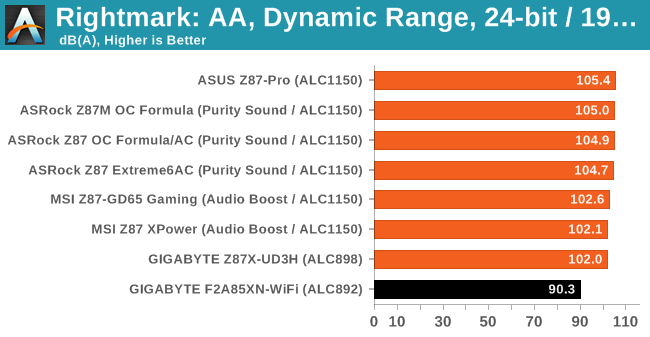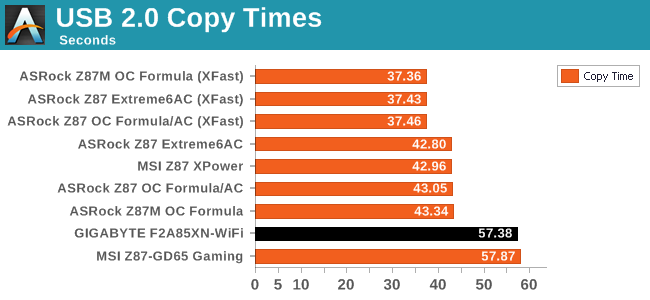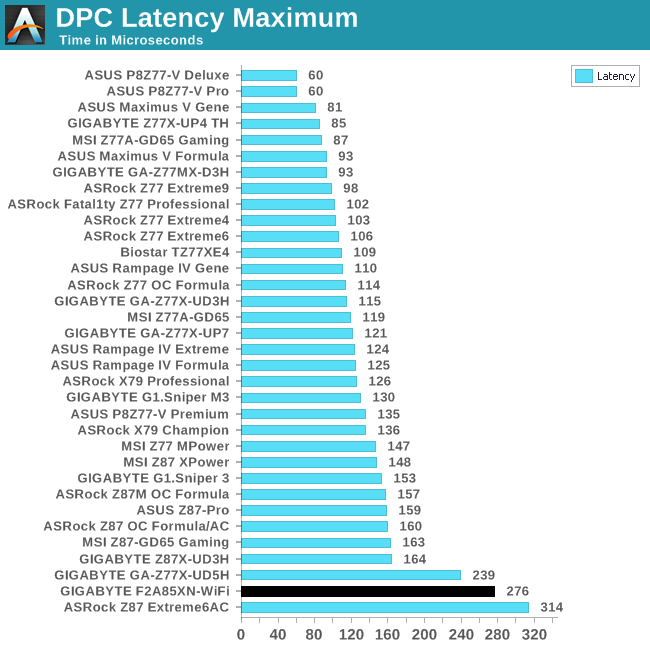GIGABYTE F2A85XN-WiFi Review: FM2 and Richland in mini-ITX
by Ian Cutress on August 21, 2013 10:00 AM ESTSystem Benchmarks
Rightmark Audio Analyzer 6.2.5
In part due to reader requests, we are pleased to include Rightmark Audio Analyzer results in our benchmark suite. The premise behind Rightmark:AA is to test the input and output of the audio system to determine noise levels, range, harmonic distortion, stereo crosstalk and so forth. Rightmark:AA should indicate how well the sound system is built and isolated from electrical interference (either internally or externally). For this test we connect the Line Out to the Line In using a short six inch 3.5mm to 3.5mm high-quality jack, turn the OS speaker volume to 100%, and run the Rightmark default test suite at 192 kHz, 24-bit. The OS is tuned to 192 kHz/24-bit input and output, and the Line-In volume is adjusted until we have the best RMAA value in the mini-pretest. We look specifically at the Dynamic Range of the audio codec used on board, as well as the Total Harmonic Distortion + Noise.


Using the Realtek ALC892 means we do not get full support on 24-bit 192 kHz, resulting in 16-bit being the max options in our OS setup. Nevertheless we were able to run the test at 24-bit, resulting in a reasonable THD+N, although the dynamic range is not comparable to some of the higher Realtek solutions.
USB Backup
For this benchmark, we run CrystalDiskMark to determine the ideal sequential read and write speeds for the USB port using our 240 GB OCZ Vertex3 SSD with a SATA 6 Gbps to USB 3.0 converter. Then we transfer a set size of files from the SSD to the USB drive using DiskBench, which monitors the time taken to transfer. The files transferred are a 1.52 GB set of 2867 files across 320 folders – 95% of these files are small typical website files, and the rest (90% of the size) are the videos used in the WinRAR test. In an update to pre-Z87 testing, we also run MaxCPU to load up one of the threads during the test which improves general performance up to 15% by causing all the internal pathways to run at full speed.


Despite using MaxCPU in our test to wake up the CPU and the relevant parts of the motherboard, we get performance similar to the Z87-GD65 Gaming on USB 2.0 and USB 3.0 performance is slower than Intel.
DPC Latency
Deferred Procedure Call latency is a way in which Windows handles interrupt servicing. In order to wait for a processor to acknowledge the request, the system will queue all interrupt requests by priority. Critical interrupts will be handled as soon as possible, whereas lesser priority requests, such as audio, will be further down the line. So if the audio device requires data, it will have to wait until the request is processed before the buffer is filled. If the device drivers of higher priority components in a system are poorly implemented, this can cause delays in request scheduling and process time, resulting in an empty audio buffer – this leads to characteristic audible pauses, pops and clicks. Having a bigger buffer and correctly implemented system drivers obviously helps in this regard. The DPC latency checker measures how much time is processing DPCs from driver invocation – the lower the value will result in better audio transfer at smaller buffer sizes. Results are measured in microseconds and taken as the peak latency while cycling through a series of short HD videos - under 500 microseconds usually gets the green light, but the lower the better.

As mentioned previously in the review, having ET6 enabled causes DPC Latency spikes every 3 seconds or so as the software polls all the sensors on the motherboard. With this disabled, we still get a higher DPC Latency score than most of the motherboards we have tested, but it still under a 500 microsecond ceiling. Ideally we really want it under 200, or 100 at best.










31 Comments
View All Comments
DanNeely - Wednesday, August 21, 2013 - link
Every time I look at the ultra-crowded layout of an mITX board I'm reminded of how dated the main 24 ATX power plug is and how much it would benefit from being replaced. While they were king in the p1 era with the CPU and PCI busses running on 3.3v directly and most other chips on the board designed for 5V; 3.3 and 5V are barely used at all any more but have 3 and 5 wires in the 24pin cable; while -5V has been removed entirely from modern versions of the spec. Dropping to a single 3.3/5v wire and removing the -5v one would free 7 pins directly; and with only 4 power pins left in the legacy connector (3.3, 5, 2 x 12) there's no need for 8 ground pins either. Probably we could drop 5 of them.This would allow for a successor cable that's only half as large; freeing space on crowded boards and replacing the 24wire cable with a 12 wire one that would be much less of a pain to route in a crowded case. I'm inclined to keep the CPUs 12V separate just to avoid trading one overly fat wire bundle for another and because AIUI the other half of why the CPUs 12V comes in separately is to get it as close to the socket as possible without crowding the area with everything else.
EnzoFX - Wednesday, August 21, 2013 - link
Yes, I've been saying this since ITX was taking hold. It is absurd how held back we are by entrenched standards. It's not in their business to reinvent.Jambe - Thursday, August 22, 2013 - link
I enjoyed this astute observation-comment.Right on.
That is all.
cjs150 - Friday, August 23, 2013 - link
Totally agree on the ATX cable.While we are at why do motherboards virtually never come with the ATX connector being at right angles rather than straight up - we get that for SATA connectors and it seriously improves cable management
flemeister - Friday, August 23, 2013 - link
Not such a good idea for mITX boards, when you might expect to install them in small cases such as the Antec ISK110 or Minibox M350. Right-angled ATX power or sata ports would be blocked off.How about RAM though? Why not use SO-DIMMs that are about 60% the size of regular DIMMs? They're readily available, and are priced the same or very close to the price of regular size RAM. Assuming two sticks of RAM, that would save even more room on the motherboard than a redesign of the 24-pin connector. Just look at the Asus P8H67-I Deluxe for an example. :)
DanNeely - Friday, August 23, 2013 - link
It's not just mITX boards that would have a problem with right angled ATX power sockets. Unless the PSU also included a right angle 24pin cable it would be problematic in any case that uses cable management holes to route the cables behind the mobo tray. Trying to make a 90* bend in that cramped a space would put a lot of torque on the socket; a big ugly loop sticking up allows for a much looser and less stressful bend.DanNeely - Friday, August 23, 2013 - link
For dimm sizes I think it's mostly a capacity issue. For more modest builds it probably doesn't matter; but higher capacities tend to come out a year or two sooner in full size dimms because you can jam more chips onto them if need be. Currently DDR3 dimms and sodimms both max out at 8GB for desktops; but if you're willing to pay the price premium server ram is available in up to 32GB dimms.flemeister - Saturday, August 24, 2013 - link
True, but how about SO-DIMMs on a budget Intel H81/B85 or AMD A55/A75 board? Or one of the low-power Intel Atom or AMD Brazos ITX boards? Or even a budget Z87 ITX board, to avoid the need for a vertically mounted VRM daughterboard (unless that's actually cheaper to do)? More space for surface mounted components, and probably cheaper to make the board? Could also mean less PCB layers?DanNeely - Saturday, August 24, 2013 - link
You're only saving 36 pins/dimm (204 vs 240); so there's no where near enough savings to drop a PCB layer. Beyond that I'd guess that since they do offer some models with SoDIMM slots that they just don't sell as well. If I had to guesses why it'd be that people are more likely to have spare DIMMs laying around than spare SoDIMMs; meaning that the total build cost is lower since the ram is free and/or the cost savings from larger DIMMs are enough to drive shoppers.The one configuration I could see driving some enthusiast/gamer consumption of SoDIMM based mITX boards would be 4 slots instead of only 2 for 32GB max instead of 16; is conspicuous by its absence.
Hyoyeon - Wednesday, August 21, 2013 - link
You mention DisplayPort several times, but this board does not have a DP connector. Where did this come from?